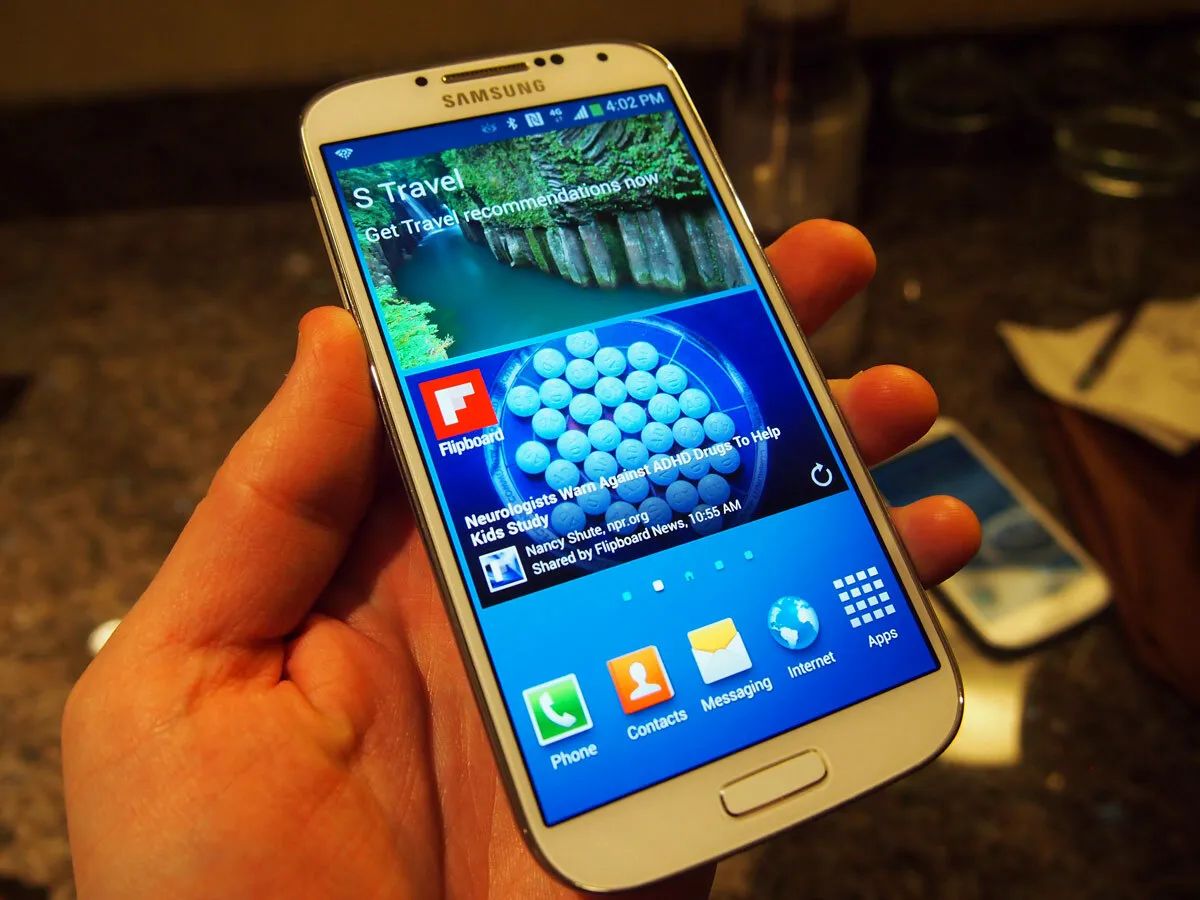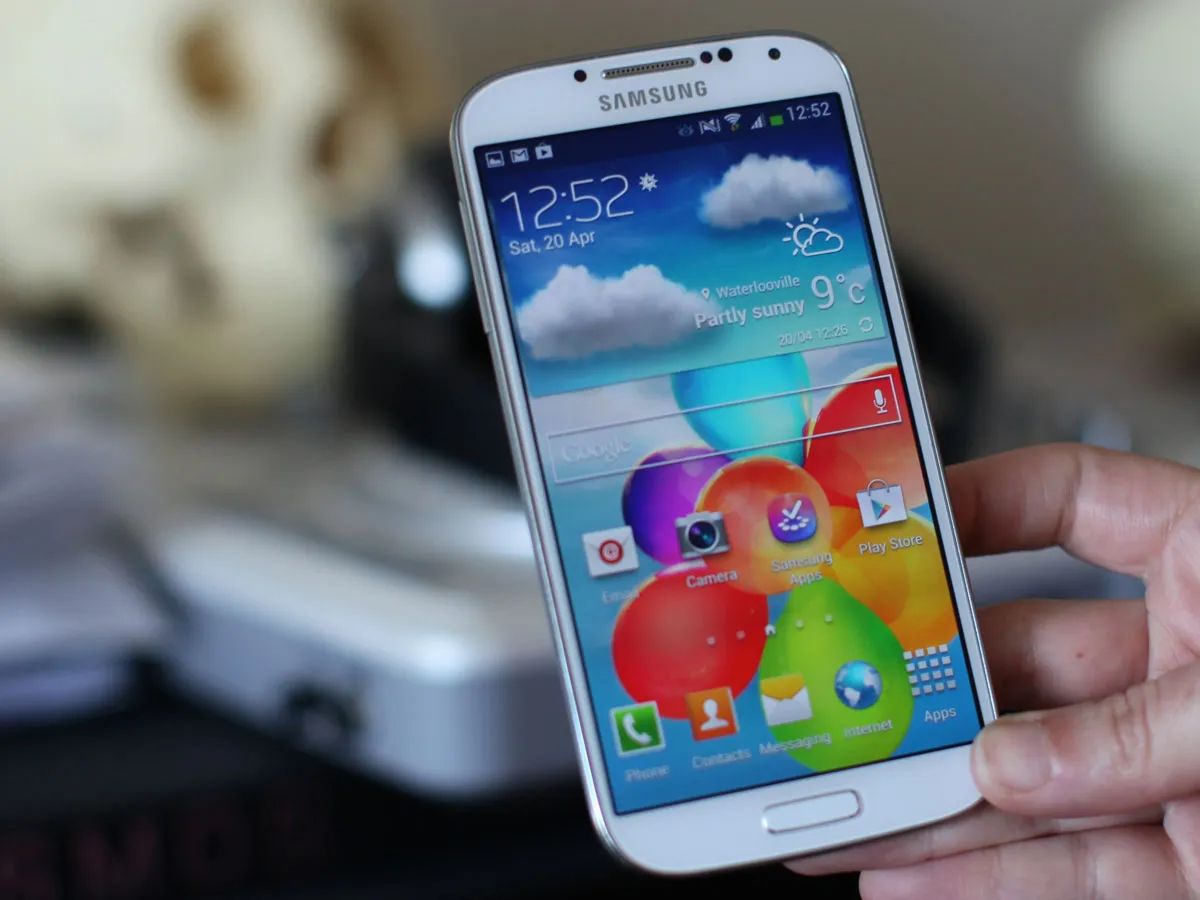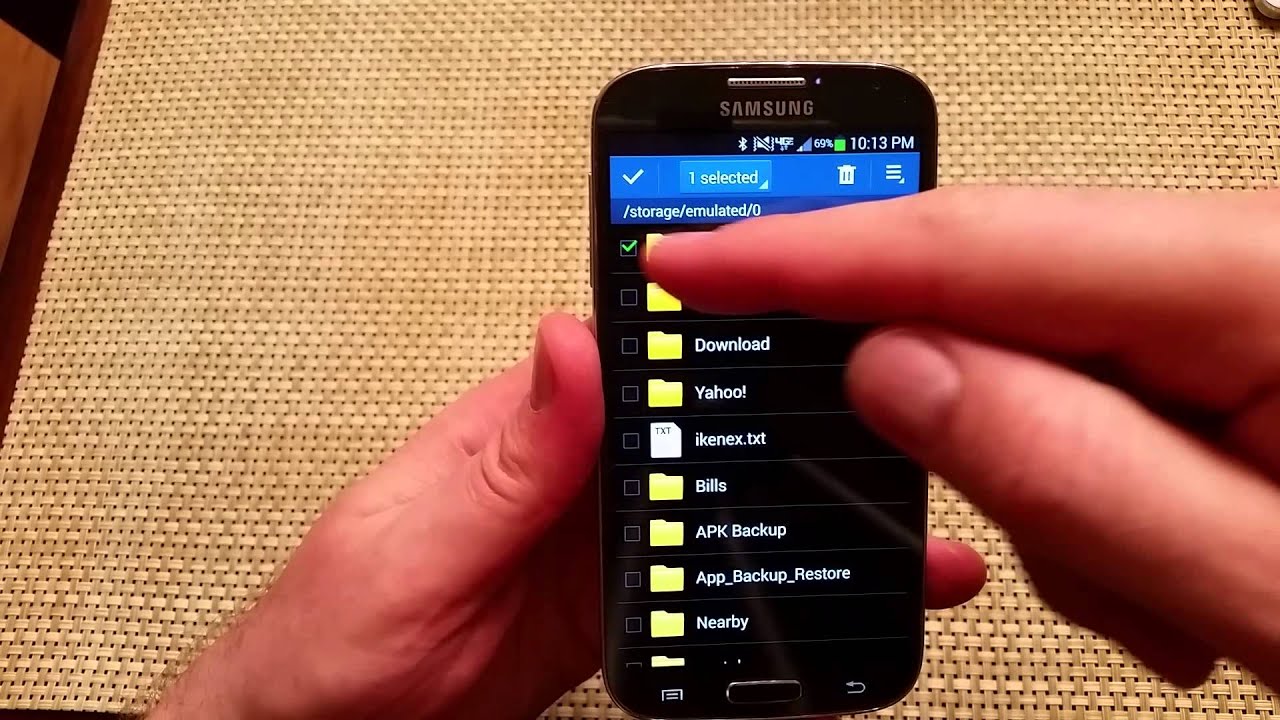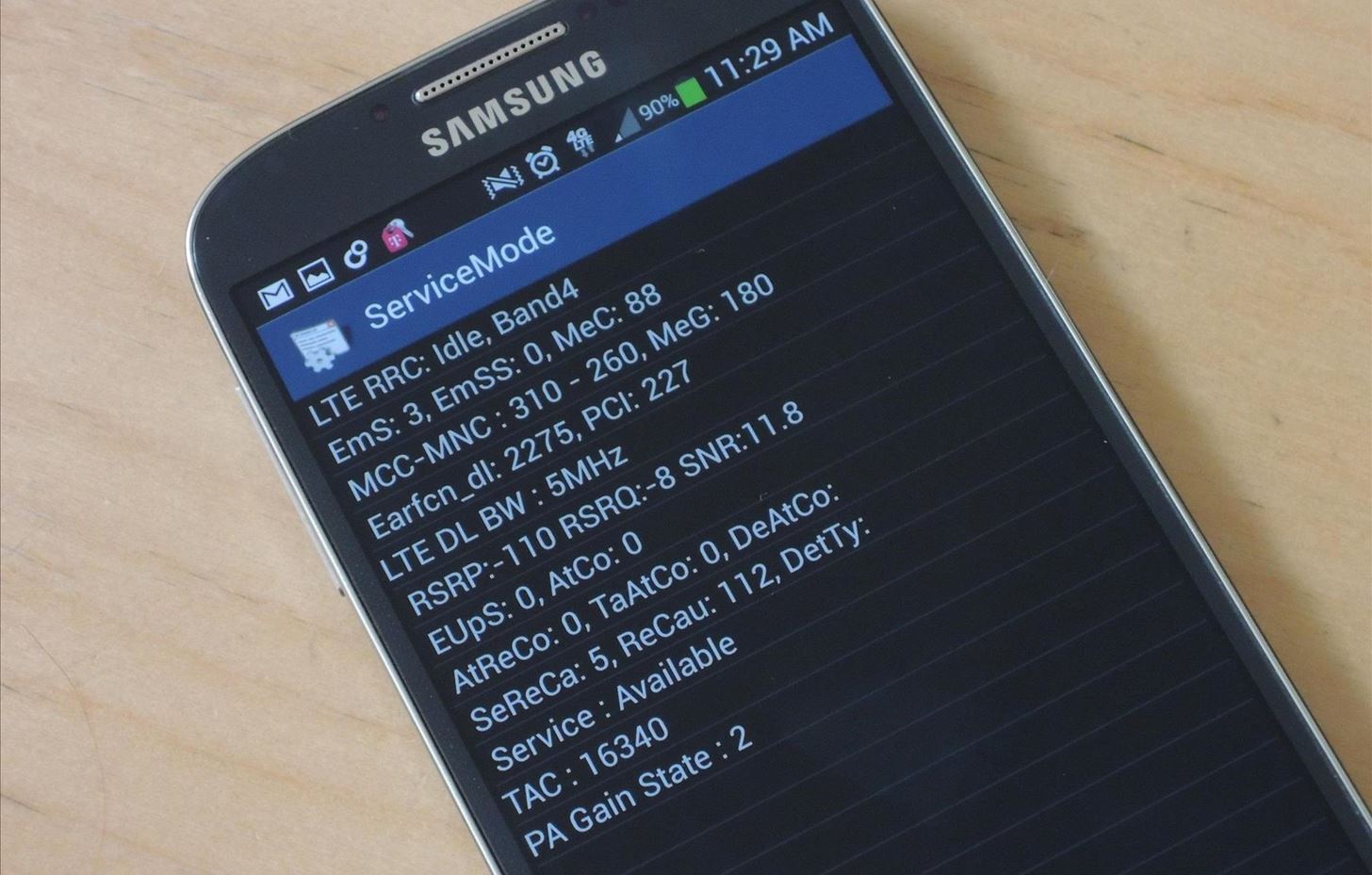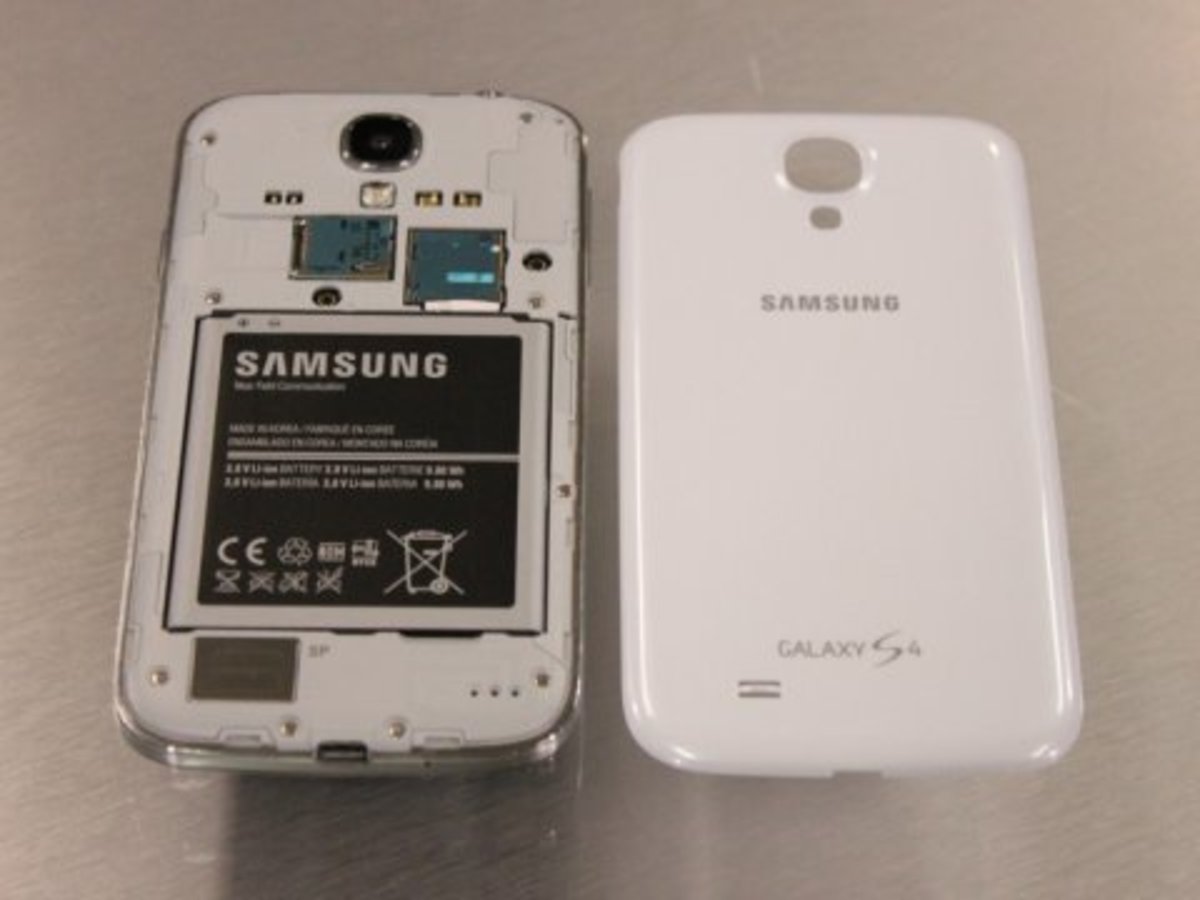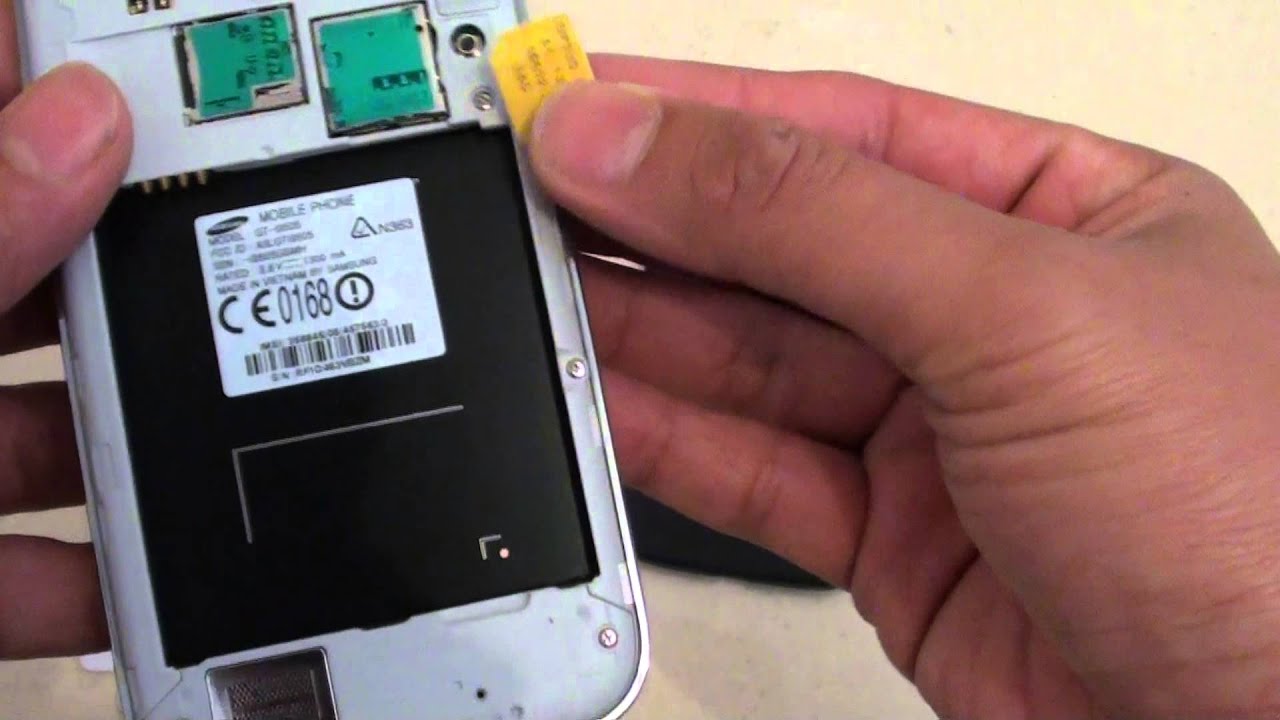Getting Started
Welcome to the wonderful world of the Samsung Galaxy S4! Whether you’re a first-time smartphone user or have upgraded from a previous model, this guide will help you get started with your new device. The Galaxy S4 offers a plethora of features and capabilities, and we’ll walk you through the essentials to ensure you make the most of your smartphone experience.
First, let’s start with the basics. To turn on your Galaxy S4, simply press and hold the power button located on the right-hand side of the device. Once powered on, you’ll be greeted with the vibrant display and intuitive interface that Samsung is known for.
Unlocking your Galaxy S4 is as easy as swiping your finger across the screen. By default, you’ll be taken to the home screen where you can find your apps and widgets. Take some time to familiarize yourself with the layout and organization of the icons, as this will be your gateway to everything your phone has to offer.
To access the main settings menu, swipe down from the top of the screen to reveal the notification panel, and then tap the gear icon. Here, you can adjust various settings such as Wi-Fi, Bluetooth, display brightness, and more. Feel free to customize these settings to suit your preferences and needs.
One of the standout features of the Galaxy S4 is its powerful and intuitive camera. To launch the camera app, simply tap on the camera icon. From here, you can capture stunning photos and record high-quality videos. Experiment with the different shooting modes and settings to unleash your inner photographer.
Finally, it’s essential to protect your Galaxy S4 with a case and screen protector. These accessories will help safeguard your device against accidental drops and scratches, ensuring its longevity and value. Additionally, you may want to consider backing up your data regularly to prevent any potential loss.
In summary, getting started with the Samsung Galaxy S4 is a breeze. Power on your device, explore the home screen and settings menu, familiarize yourself with the camera features, and take steps to protect your investment. With this knowledge, you’re well on your way to unlocking the full potential of your smartphone. Next, let’s dive into the various ways you can navigate your Galaxy S4.
Navigating Your Galaxy S4
Now that you’ve got your Samsung Galaxy S4 up and running, let’s explore the different ways you can navigate through its features and functions. The Galaxy S4 offers a user-friendly interface that allows for effortless navigation. Whether you prefer to use physical buttons or touch gestures, here’s how you can efficiently move around your device.
Starting with the physical buttons, the Galaxy S4 features a home button located at the bottom center of the device. Pressing this button will always take you back to the home screen, no matter where you are within an app or menu. On either side of the home button, you’ll find the capacitive back button on the right and the menu button on the left. These buttons provide additional navigation options depending on the context of the screen you’re on.
Alternatively, you can use touch gestures to navigate your Galaxy S4. Swiping down from the top of the screen will open the notification panel, giving you quick access to various settings and notifications. Swiping up from the bottom of the screen will reveal the app drawer, where you can find all your installed applications. If you want to switch between recently used apps, simply swipe left or right from the home button to access the app switcher.
Another handy navigation feature is the ability to use gestures without touching the screen. This feature, known as Air Gesture, allows you to control certain actions by waving your hand over the device. For example, you can answer or reject calls, scroll through web pages, or navigate through photo galleries without actually touching the screen. To enable Air Gesture, go to Settings > My Device > Motions and Gestures.
Additionally, the Galaxy S4 offers a multi-window feature that enables you to run two apps simultaneously, side by side. This can be particularly useful when you want to multitask and view information from different apps at the same time. To activate multi-window mode, press and hold the back button until the side panel appears, then select the desired app to open alongside your current one.
In summary, navigating through your Galaxy S4 is a breeze, whether you prefer using physical buttons or touch gestures. Take advantage of the home, back, and menu buttons to navigate effortlessly through the interface. Explore the various touch gestures, including swiping down for notifications and up for the app drawer. Consider enabling Air Gesture for hands-free control, and don’t forget to explore the multi-window feature for enhanced multitasking. With these navigation tips, you’ll be able to effortlessly explore all the features and functions of your Samsung Galaxy S4.
Customizing Your Home Screen
One of the great things about the Samsung Galaxy S4 is the ability to customize your home screen to match your personal style and preferences. The home screen is where you’ll find your most-used apps and widgets, and with a few simple steps, you can transform it into a personalized digital showcase. Here are some tips on how to customize your home screen and make it truly unique.
To begin customizing your home screen, start by long-pressing on any blank area of the screen. This will bring up the customization options, including the ability to change your wallpaper, add widgets, and rearrange or add app icons. Let’s start with the wallpaper.
You can select a pre-installed wallpaper or choose an image from your photo gallery as your wallpaper. This will be the background image that appears behind your app icons and widgets. To change your wallpaper, tap on the “Wallpapers” option, and you’ll be presented with a variety of options to choose from. Select your desired wallpaper and apply it to your home screen.
Next, let’s add some widgets to your home screen. Widgets are like mini-apps that provide quick access to information or perform specific functions. To add a widget, long-press on a blank area of your home screen, then tap on the “Widgets” option. You’ll see a list of available widgets categorized by apps. Tap on a widget to preview it, then drag it and release it on the desired spot on your home screen. You can resize the widget by long-pressing on it and adjusting the handles that appear.
Now that you have your wallpaper and widgets set up, let’s organize your app icons. You can rearrange the app icons by long-pressing on an icon and dragging it to a new position. You can also create folders to group similar apps together. To create a folder, drag an app icon on top of another app icon. A folder will be created, and you can give it a name. Add more apps to the folder by dragging and dropping them onto the folder.
In addition to rearranging and organizing your app icons, you can also customize the appearance of the app drawer. The app drawer is where all your installed apps are located. To access the app drawer, swipe up from the bottom of the home screen. From here, you can arrange the apps alphabetically, by frequency of use, or in a custom order. You can also hide apps from the app drawer if you don’t want them to appear.
Finally, if you want to add some personal flair to your home screen, you can download and apply custom icon packs from the Google Play Store. Icon packs come with a variety of different icon styles and designs to choose from, allowing you to truly make your home screen your own.
In summary, customizing your home screen on the Samsung Galaxy S4 is a fun and straightforward process. Change your wallpaper, add widgets for quick access to information and functions, rearrange and organize your app icons, customize your app drawer, and apply custom icon packs for a personalized touch. With these customization options, your home screen will reflect your style and enhance your smartphone experience.
Managing Apps
The Samsung Galaxy S4 offers a wide range of apps that cater to your everyday needs and entertainment desires. From productivity tools to social media apps and games, managing and organizing your apps effectively will ensure a seamless and efficient user experience. Here are some tips on how to manage your apps on the Galaxy S4.
To access and manage your apps, simply tap on the app drawer icon located at the bottom center of your home screen. The app drawer contains all the apps installed on your device. You can scroll vertically to browse through the list, or use the search bar at the top to quickly find a specific app.
If you find yourself frequently using certain apps, consider adding them to your home screen for easy access. To do this, long-press on an app icon in the app drawer, and then drag it to a vacant spot on your home screen. You can also create app folders on your home screen to group apps of similar categories together.
Managing your apps also involves keeping them up to date. Regularly check for app updates in the Google Play Store to ensure you have the latest features, bug fixes, and security patches. To access the Play Store, tap on its icon in the app drawer. Once in the Play Store, go to the “My apps & games” section to view and update your installed apps.
If you have too many apps installed and find it challenging to navigate through the app drawer, you can organize them into different categories. To create app categories, tap on the three-dot menu icon in the app drawer, then select “Create folder” or “Add category.” Give your folder or category a name, and then drag and drop apps into it accordingly.
Another useful feature for managing apps is App permissions. Each app on your Galaxy S4 may require certain permissions to function correctly. To review app permissions, go to Settings > Apps. Select the desired app from the list, then tap on “Permissions” to see what permissions the app has requested. You can enable or disable specific permissions based on your preferences and privacy concerns.
For those apps that you rarely use or no longer need, consider uninstalling them to free up storage space and declutter your device. To uninstall an app, go to Settings > Apps, select the app you want to remove, then tap on “Uninstall.” Alternatively, you can uninstall apps directly from the app drawer by long-pressing on the app icon and selecting the “Uninstall” option.
In summary, managing your apps on the Samsung Galaxy S4 is crucial for a smooth and organized user experience. Add frequently used apps to your home screen, keep your apps updated, organize them into categories or folders, review app permissions, and uninstall apps you no longer need. These tips will help you make the most of your app collection and optimize your smartphone usage.
Making Phone Calls
The Samsung Galaxy S4 is not just a smartphone; it’s also a powerful communication device that allows you to make phone calls with ease. Whether you’re making a call to a friend, family member, or business associate, the Galaxy S4 provides various features and options to enhance your calling experience. Here’s a guide on how to make phone calls on your Galaxy S4.
There are multiple ways to initiate a phone call on your Galaxy S4. The most straightforward method is to open the Phone app, which can be found on your home screen or in the app drawer. Tap on the Phone app, and you’ll see the dial pad with numbers and various calling options.
If you already have a contact saved in your phonebook, you can search for the contact by tapping on the “Contacts” tab in the Phone app. From there, you can scroll through your contacts or use the search bar to quickly find the person you want to call. Simply tap on the contact’s name, and the dial pad will appear with the contact’s phone number pre-filled.
Alternatively, you can make a call directly from the Contacts app. Open the Contacts app from your home screen or app drawer, locate the contact you want to call, and tap on their name. On the contact’s details page, you’ll find multiple options, including the phone number. Tap on the phone number, and the dial pad will appear.
If you receive a phone number from a text message, email, or website that you want to call, you can easily initiate the call without having to manually enter the number. Simply long-press on the phone number, and a pop-up menu will appear, giving you the option to call the number using the Phone app.
During a call, you’ll have access to several useful features. For example, if you need to access the dial pad during a call, you can tap on the dial pad icon located at the bottom left of the screen. This allows you to enter numbers for automated systems or make selections during a call.
If you need to place a call on hold, tap on the hold icon, which is represented by two parallel horizontal lines. This will temporarily hold the call while you attend to another task or speak with someone else. To resume the call, simply tap on the hold icon again.
If you want to switch to a different call, you can use the call waiting feature. When a second call comes in while you’re already on a call, a notification will appear on the screen. You can tap on the “Swap” option to switch between the two calls or tap on “Merge” to join them into a three-way call.
In summary, making phone calls on the Samsung Galaxy S4 is a straightforward process. Use the Phone app or Contacts app to initiate calls, take advantage of features like the dial pad, call holding, and call waiting. With these tips, you’ll be able to effortlessly make and manage phone calls on your Galaxy S4.
Sending Text Messages
Text messaging, also known as SMS (Short Message Service), is a quick and convenient way to communicate with others using your Samsung Galaxy S4. Whether you’re sending a casual message to a friend or a professional message to a colleague, the Galaxy S4 makes it easy to send and manage text messages. Here’s how you can send text messages on your Galaxy S4.
To send a text message, start by opening the Messages app on your device. You can find this app on your home screen or in the app drawer. Once opened, you’ll see your list of text message conversations. If you want to start a new message, tap on the “Compose” or “New Message” button, typically represented by a pen and paper icon.
In the recipient field, you can enter the phone number or contact name of the person you want to send the text message to. As you type, the Galaxy S4 will suggest contacts from your phonebook. You can also select multiple recipients by tapping on the “+” button next to the recipient field, allowing you to send group messages.
After entering the recipient(s), you can then type your message in the text input field. The Galaxy S4 offers a virtual keyboard that allows you to enter text. You can switch between different input methods (such as QWERTY, Swype, or handwriting recognition) by tapping on the keyboard icon at the bottom right corner of the screen.
If you want to add more to your message, such as emojis, multimedia attachments, or voice recordings, you’ll find options at the bottom of the messaging screen. The Galaxy S4 offers a wide range of emojis to help you express yourself, and you can tap on the smiley face icon to access them. To attach multimedia files, such as photos, videos, or audio recordings, tap on the paperclip icon. This will allow you to browse through your device’s storage and attach the desired file.
Once you’ve composed your message and added any desired attachments, you can review it before sending. Take a moment to ensure that the correct recipient(s) are selected and that your message is free of any errors. If everything looks good, tap on the send button, typically represented by an arrow icon.
As you send and receive text messages, the Galaxy S4 will automatically organize them into conversation threads. This makes it easy to view and reply to specific messages within a conversation. You can tap on a conversation to open it and view the entire message history with that contact.
To manage your text messages, you can use various options available in the Messages app. For example, you can delete individual messages, clear entire conversations, mark messages as read or unread, and archive important conversations for easy access.
In summary, sending text messages on the Samsung Galaxy S4 is a straightforward process. Open the Messages app, enter the recipient(s), compose your message, and optionally add attachments. Confirm the details and tap send. Use conversation threads to manage and organize your text messages. With these tips, you’ll be able to efficiently communicate with others through text messaging on your Galaxy S4.
Internet and Email
The Samsung Galaxy S4 provides a seamless and efficient way to access the internet and manage your emails. Whether you need to browse the web, check your emails, or stay connected with online services, the Galaxy S4 offers a range of features and options to enhance your internet and email experience. Here’s a guide on how to utilize the internet and email capabilities of your Galaxy S4.
To access the internet, you can use the pre-installed browser app on your Galaxy S4. This app is often labeled as “Internet” or “Browser” and can typically be found on your home screen or in the app drawer. Simply tap on the app to open it, and you’ll be presented with a search bar and various navigation options.
You can enter a website address directly in the search bar to navigate to a specific website or use the search function to look up specific information. The browser also allows you to open multiple tabs, making it easy to switch between different web pages and keep track of your browsing sessions. To open a new tab, tap on the tab icon, often represented by a square or a number, and then tap on the “+” icon to create a new tab.
In addition to the built-in browser, you can also download and install alternative web browsers from the Google Play Store. These browsers offer unique features and customization options, allowing you to personalize your browsing experience to suit your preferences.
Managing your emails on the Galaxy S4 is simple with the pre-installed Email app. This app supports a wide range of email accounts, including Gmail, Yahoo Mail, Microsoft Outlook, and many others. To set up an email account, open the Email app and follow the on-screen instructions to enter your email address and password. The app will then authenticate your account and sync your emails.
Once your email account is set up, you can easily view and manage your emails from within the app. The Email app provides you with options such as composing new emails, replying to or forwarding messages, and organizing your emails into folders or labels. You can also customize the settings to control how often the app checks for new email, set up email signatures, and enable notification alerts for new messages.
If you prefer to access your emails through a specific email provider’s app, such as the Gmail or Outlook app, you can download these apps from the Google Play Store. These specialized email apps often come with additional features and integration capabilities that may enhance your email experience.
Alongside browsing the web and managing emails, the Galaxy S4 offers various other internet-related features. You can download and use social media apps to stay connected with friends and family, stream music and videos from popular entertainment platforms, and make use of online storage services to back up and sync your important files. The possibilities are endless.
In summary, the Samsung Galaxy S4 provides a range of options for accessing the internet and managing your emails. Use the pre-installed browser app or alternative web browsers to browse the web. Set up your email accounts in the Email app or download specialized email apps for a tailored email experience. Take advantage of other internet-related features like social media, multimedia streaming, and online storage. With these features, your Galaxy S4 becomes a versatile tool for staying connected and accessing online content.
Taking Photos and Videos
The Samsung Galaxy S4 is equipped with a powerful camera that allows you to capture stunning photos and videos with ease. Whether you’re a photography enthusiast or simply enjoy capturing precious moments, the Galaxy S4 offers a range of features and settings to enhance your photography experience. Here’s a guide on how to take photos and videos on your Galaxy S4.
To access the camera on your Galaxy S4, you can either open the Camera app from your home screen or swipe left on the lock screen to go straight to the camera. Once in the camera app, you’ll see the viewfinder, which displays what the camera sees.
To take a photo, simply frame your shot using the viewfinder and tap on the capture button, usually represented by a circular icon. The Galaxy S4 camera also supports touch focus, allowing you to tap on specific areas of the screen to adjust the focus before taking the photo. This feature is especially useful when you want to emphasize a particular subject in your shot.
For more advanced photography options, you can explore the settings and modes available in the camera app. By tapping on the gear icon or swiping right, you can access features such as HDR (High Dynamic Range) mode, which captures a wider range of lighting in a scene, or the panorama mode, which allows you to capture wide, sweeping landscapes.
If you want to capture fast-moving subjects or create unique effects, you can experiment with the various shooting modes available on the Galaxy S4. These modes include Sports mode, which captures moving subjects with reduced blur, and Drama mode, which creates a composite image with multiple exposures of a moving subject.
The Galaxy S4 camera also offers a range of editing features that allow you to enhance your photos without the need for additional editing apps. After capturing a photo, you can tap on the photo thumbnail to access the editing options. Here, you can apply filters, adjust brightness and contrast, crop or rotate the image, and even add text or doodles.
In addition to capturing photos, the Galaxy S4 camera allows you to record high-quality videos. Simply switch to video mode by tapping on the video camera icon in the camera app. You can then start and stop the video recording by tapping on the corresponding icon. The camera app also allows you to change video resolution and enable video stabilization to minimize camera shake.
After capturing photos and videos, you can easily access them in the Gallery app, which can be found on your home screen or in the app drawer. The Gallery app allows you to organize and view your media files, apply additional edits if desired, and easily share them with others via social media, messaging apps, or email.
In summary, the Samsung Galaxy S4 offers a versatile camera that allows you to capture high-quality photos and videos. Experiment with the various shooting modes and settings, apply edits directly within the camera app, and easily access and share your media files in the Gallery app. With these features and options, you’ll be able to unleash your creativity and capture memorable moments with your Galaxy S4.
Using Social Media
The Samsung Galaxy S4 provides a seamless and convenient way to stay connected with friends, family, and the world through social media platforms. From Facebook and Twitter to Instagram and Snapchat, the Galaxy S4 offers a range of features and apps to enhance your social media experience. Here’s a guide on how to use social media on your Galaxy S4.
To access your favorite social media apps, simply locate and tap on the respective app’s icon on your home screen or in the app drawer. If you haven’t installed a particular social media app, you can easily download it from the Google Play Store. Once installed, open the app and sign in using your account credentials.
With social media apps, you can browse through your feed to see updates from your friends and the pages you follow. You can like, comment on, and share posts, photos, and videos. The Galaxy S4 offers a user-friendly interface that makes it easy to navigate through various app features and interact with content.
Additionally, the Galaxy S4 allows you to receive notifications for social media activity, ensuring you’re always up to date with the latest posts and messages. You can customize your notification settings for each app to control which types of notifications you want to receive and how often.
The Galaxy S4 also supports features like chat or messaging within social media apps. For apps like Facebook Messenger, WhatsApp, or Snapchat, you can engage in direct conversations with your friends, send photos and videos, and even make voice or video calls right from within the app.
Furthermore, the Galaxy S4 offers easy sharing functionality, allowing you to effortlessly share content from other apps or the web to your social media platforms. For example, you can share photos directly from your Gallery app or share a link to an interesting article you come across while browsing the internet.
If you enjoy sharing visual content, you can take advantage of the Galaxy S4’s powerful camera to capture photos and videos to share directly to your social media accounts. The Galaxy S4’s camera app often integrates with social media platforms, making it quick and convenient to share your moments with your followers.
For those who enjoy managing multiple social media accounts, the Galaxy S4 allows you to install and access multiple social media apps simultaneously. This enables you to switch between accounts and stay connected with different communities and networks from a single device.
In summary, the Samsung Galaxy S4 offers a range of features and apps to enhance your social media experience. Use social media apps to browse, interact, and stay connected with friends and the world. Customize your notification settings, engage in conversations, share content, and leverage the powerful camera capabilities to capture and share your moments. With the Galaxy S4, you’ll be able to enjoy social media conveniently and effortlessly.
Music and Media
The Samsung Galaxy S4 not only serves as a communication device but also as a multimedia powerhouse, allowing you to enjoy your favorite music and media on the go. With its vibrant display and powerful audio capabilities, the Galaxy S4 offers a wide range of features and apps to enhance your music and media experience. Here’s a guide on how to make the most of music and media on your Galaxy S4.
To enjoy your favorite music on the Galaxy S4, you can use the pre-installed Music app. Open the app from your home screen or app drawer, and you’ll find a user-friendly interface that allows you to browse through your music library, create playlists, and control playback. The Galaxy S4 supports various audio formats, so you can listen to your favorite songs without any compatibility issues.
The Galaxy S4 also supports streaming music services, such as Spotify, Apple Music, or Google Play Music. Simply download and install your preferred music streaming app from the Google Play Store, sign in to your account, and start exploring millions of songs and personalized playlists. The Galaxy S4’s powerful speakers or headphone jack let you enjoy your music with high-quality sound.
In addition to music, the Galaxy S4 allows you to enjoy a wide range of media files. The pre-installed Video app offers a convenient way to watch videos, movies, and TV shows on your device. You can also download alternative video player apps from the Google Play Store to access additional features and customization options.
If you have a collection of photos and videos stored on your Galaxy S4 or in cloud storage services like Google Photos or Dropbox, you can easily view and organize them using the Gallery app. The Gallery app provides a visually pleasing interface to browse through your media files and offers options to create albums, edit photos, and share them with others through various platforms.
When it comes to reading e-books or digital magazines, the Galaxy S4 offers a comfortable reading experience. You can download e-book reader apps like Kindle or Google Play Books from the Google Play Store and access a vast library of e-books, while the Flipboard app provides a visually engaging way to discover and read digital magazines.
For those who enjoy podcasts, the Galaxy S4 allows you to access and subscribe to your favorite podcasts using apps like Spotify, Google Podcasts, or Pocket Casts. These apps provide an extensive catalog of podcasts across various genres and allow you to download or stream episodes for offline or online listening.
Lastly, the Galaxy S4 supports screen mirroring and casting technologies, such as Chromecast or Smart View. With these features, you can stream audio or video content from your device to a compatible smart TV, allowing for a larger and more immersive media experience.
In summary, the Samsung Galaxy S4 offers a versatile platform for enjoying music and media. Use the pre-installed Music and Video apps to enjoy your music and videos. Explore music streaming services, video player apps, and e-book reader apps for a broader range of content. Organize and view your photos and videos using the Gallery app, and access podcasts on the go. With the Galaxy S4, you can immerse yourself in a world of entertainment and media.
Syncing and Transferring Files
The Samsung Galaxy S4 offers versatile options for syncing and transferring files, allowing you to keep your important data up to date and easily share files with other devices. Whether you need to sync your contacts, transfer files between your Galaxy S4 and a computer, or share files with other devices wirelessly, the Galaxy S4 provides various methods to meet your needs. Here’s a guide on how to sync and transfer files on your Galaxy S4.
To sync your contacts, calendar events, and other data, the Galaxy S4 offers built-in synchronization capabilities with popular email services, such as Gmail, Microsoft Exchange, and Yahoo Mail. When you set up your email accounts on your Galaxy S4, you can choose to sync your contacts and calendar data, ensuring that any changes you make on your device are reflected across all your connected devices.
If you want to transfer files between your Galaxy S4 and a computer, you can use the USB cable that came with your device. Connect one end of the cable to your Galaxy S4 and the other end to a USB port on your computer. Once connected, your Galaxy S4 will appear as a removable storage device on your computer. You can then simply drag and drop files between your phone and computer, just like you would with a regular USB flash drive.
In addition to using the USB cable, you can also transfer files wirelessly between your Galaxy S4 and other devices. The Galaxy S4 supports Bluetooth file transfer, which allows you to send and receive files between your phone and other Bluetooth-enabled devices, such as smartphones, tablets, or laptops. Simply pair your Galaxy S4 with the target device, select the file you want to transfer, and choose the option to send it via Bluetooth.
For faster and more convenient file transfers, you can use Wi-Fi Direct. Wi-Fi Direct enables you to establish a direct connection between your Galaxy S4 and another Wi-Fi Direct-compatible device, such as a smartphone or a smart TV. This allows you to transfer files at high speeds without the need for an internet connection or a separate access point. Simply enable Wi-Fi Direct on both devices and follow the on-screen instructions to establish the connection and transfer files.
If you have a large number of files or want to back up your data to the cloud, you can take advantage of cloud storage services such as Google Drive, Dropbox, or Microsoft OneDrive. These services allow you to upload and store your files in the cloud, giving you access to them from any device with an internet connection. Simply install the respective app on your Galaxy S4, sign in to your account, and start uploading or syncing your files.
In summary, the Samsung Galaxy S4 offers multiple options for syncing and transferring files. Sync your contacts and calendar data by setting up email accounts on your device. Use the USB cable to transfer files between your Galaxy S4 and a computer. Utilize Bluetooth file transfer or Wi-Fi Direct for wireless file transfers. Consider using cloud storage services for backing up and accessing your files from multiple devices. With these options, you can easily keep your data in sync and seamlessly transfer files on your Galaxy S4.
Battery and Storage Management
To ensure optimal performance and longevity of your Samsung Galaxy S4, it is important to effectively manage your device’s battery and storage. By implementing certain strategies and utilizing built-in features, you can extend your battery life and free up valuable storage space. Here’s a guide on how to manage the battery and storage on your Galaxy S4.
Battery Management:
One of the primary concerns for smartphone users is battery life. To prolong the battery life of your Galaxy S4, consider implementing the following practices:
- Adjust the screen brightness to an optimal level. Lowering the brightness level can significantly reduce battery consumption.
- Disable or reduce the frequency of background app refresh. This can be done in the settings of individual apps or in the device’s settings menu.
- Minimize the use of live wallpapers, as they tend to drain battery power. Opt for static wallpapers instead.
- Turn off unused connectivity features such as Wi-Fi, Bluetooth, and NFC when not in use.
- Enable power-saving mode, available in the settings menu, to conserve battery power when it is running low.
- Close unnecessary apps running in the background. This can be done by accessing the multitasking menu and swiping away the apps you are not actively using.
Storage Management:
The Galaxy S4 comes with built-in storage, which can fill up over time as you install apps, capture photos and videos, and save other files. To effectively manage your device’s storage space, consider the following tips:
- Regularly delete unnecessary files, such as duplicate photos, screenshots, or outdated documents. Use the pre-installed file manager app or a third-party file manager app to navigate and delete files.
- Transfer files, such as photos and videos, to an external storage device or a cloud storage service to free up internal storage space.
- Uninstall unused or rarely used apps to reclaim storage space. To uninstall an app, go to the settings menu, select “Apps,” and choose the app you want to remove, then tap on “Uninstall.”
- Clear cache files regularly. Go to the settings menu, select “Storage,” then tap on “Cached data” to clear cached files from apps.
- Utilize a microSD card to expand your storage capacity. The Galaxy S4 supports microSD cards, allowing you to store additional files externally.
- Utilize cloud storage services, such as Google Drive or Dropbox, to store files and access them from any device with an internet connection.
By implementing these battery and storage management practices, you can optimize the performance and longevity of your Samsung Galaxy S4. Conserving battery power and effectively managing storage space will ensure that your device operates smoothly and efficiently for an extended period.
Troubleshooting Common Issues
While the Samsung Galaxy S4 is a reliable device, it is not immune to occasional issues or glitches. Fortunately, with a few troubleshooting techniques, you can resolve most common problems that may arise. Here are some troubleshooting steps to help you overcome common issues on your Galaxy S4.
1. Device Freezing or Lagging:
If your Galaxy S4 becomes unresponsive or starts to lag, try the following steps:
- Restart your device by holding down the power button and selecting “Restart” from the menu.
- Clear cache partition by turning off the device, then holding the power, home, and volume up buttons simultaneously until the Samsung logo appears.
- Uninstall unnecessary apps or perform a factory reset if the issue persists.
2. Battery Draining Quickly:
If your battery drains faster than usual, try these tips to improve battery life:
- Reduce screen brightness or enable automatic brightness adjustment.
- Minimize background app refresh and close unused apps running in the background.
- Disable features like Wi-Fi, Bluetooth, or NFC when not in use.
- Enable power-saving mode from the settings menu.
3. Connectivity Issues:
If you’re experiencing connectivity problems with Wi-Fi or mobile data, try these troubleshooting steps:
- Toggle Wi-Fi or mobile data off and on again from the quick settings panel or settings menu.
- Forget and reconnect to Wi-Fi networks.
- Reset network settings by going to “Settings,” “General Management,” “Reset,” and selecting “Reset network settings.”
- Restart your device and modem/router.
4. Overheating:
If your Galaxy S4 becomes excessively hot, follow these steps:
- Remove any unnecessary cases or covers that may be obstructing heat dissipation.
- Avoid using your device in direct sunlight or extreme temperature conditions.
- Close resource-intensive apps and avoid multitasking excessively.
5. App Crashes:
If certain apps on your Galaxy S4 crash or freeze frequently, try these troubleshooting tips:
- Update the app to the latest version from the Google Play Store.
- Clear the app cache and data from the app settings menu.
- Uninstall and reinstall the app if the issue persists.
- Contact the app developer for further assistance.
If the above troubleshooting steps do not resolve the issue, it’s recommended to contact Samsung support or your service provider for further assistance. They can provide specific guidance tailored to your device and situation.
By following these troubleshooting techniques, you can effectively address and resolve common issues on your Samsung Galaxy S4. With a little patience and these troubleshooting steps in your arsenal, you’ll be able to maintain a smooth and reliable performance for your device.
Useful Tips and Tricks
The Samsung Galaxy S4 is packed with features and capabilities that can enrich your smartphone experience. Here are some useful tips and tricks to help you make the most of your Galaxy S4:
- S Voice: Take advantage of S Voice, Samsung’s virtual assistant, by using voice commands to perform tasks like setting alarms, sending text messages, or making phone calls. Simply double-tap the home button or say the designated wake-up command to activate S Voice.
- Smart Stay: Enable Smart Stay in the settings menu to keep the screen on as long as you’re looking at it. This feature uses the front-facing camera to detect your eyes and prevent the screen from turning off when you’re actively using your device.
- One-Handed Operation: If you find it challenging to navigate the larger display with one hand, enable one-handed mode in the settings menu. This feature scales down the screen size, making it easier to reach all areas of the interface with one hand.
- Multi-Window Mode: Make the most of the Galaxy S4’s multitasking capabilities by using multi-window mode. To activate it, press and hold the back button until the side panel appears. From there, you can select two apps to run simultaneously side-by-side.
- Quick Settings: Access commonly used settings quickly by swiping down from the top of the screen to reveal the notification panel, then swipe again to view the quick settings panel. From here, you can toggle settings like Wi-Fi, Bluetooth, and screen brightness without going into the main settings menu.
- Smart Screen: Utilize the Smart Screen feature to enhance your viewing experience. Enable Smart Stay to keep the screen on while you’re actively looking at it, or enable Smart Rotate to adjust the screen orientation based on the position of your face.
- Camera Shortcut: Access the camera quickly by double-pressing the home button from any screen, including the lock screen. This shortcut allows you to capture spontaneous moments without the need to unlock your device and launch the camera app.
- Gesture Controls: Enable motion and gesture controls in the settings menu to enhance the convenience of operating your Galaxy S4. Features like Air Gesture, Smart Scroll, and Air View allow you to perform actions like scrolling through web pages, previewing content, and answering calls without touching the screen.
- Data Usage Monitoring: Keep track of your data usage to avoid exceeding your monthly allowance. Go to the settings menu, select “Connections,” then “Data usage” to view your data usage statistics and set up data usage limits or warnings to manage your data consumption.
- Do Not Disturb: Ensure uninterrupted sleep or focused work time by activating the Do Not Disturb mode. From the settings menu, select “Sounds and vibration,” then “Do Not Disturb.” Set the desired schedule or enable it manually to silence notifications and calls during designated hours.
By implementing these tips and tricks, you can enhance your productivity, enjoyment, and overall user experience on your Samsung Galaxy S4. Have fun exploring the capabilities of your device and discovering even more features to tailor it to your preferences and needs.







